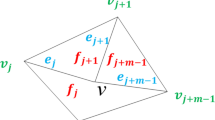Abstract
Global interference detection and avoidance are key issues in tool path planning for five-axis machining of complex surfaces. Improving the detection accuracy and efficiency has always been the main goal of global interference research. In this paper, a novel method for fast interference judgment is proposed. First, the four planes with X or Y extremum are obtained by the intersection operation between the plane and the machined surface and solving extremum, respectively. Then, the four boundaries of the initial interference detection area are obtained by intersecting the four extreme planes with the machined surface. To determine whether there is collision interference between the tool and the machined part, the shortest distance between the tool axis and the detection area is used for interference judgment. The shortest distance can be obtained by calculating the distance between the discrete point in the detection area and the tool axis. In order to ensure the uniformity of the discrete points, the discretization of points was carried out in the projection area of the initial detection area on the XOY plane, rather than on the part surface. For improving the efficiency of interference detection, the four-sided constraint method is used to screen the discrete points in the initial detection area. Only the points satisfying the screening conditions can be used as effective detection points to calculate the distances, and the shortest distance can be found from all the calculated distances. In this paper, the subdivision technology is used to achieve high-precision interference detection. At the end of the paper, the interference detection algorithm was tested by two examples, and the correctness of the test results was verified by the VERICUT simulation and cutting experiment. The proposed algorithm can be applied to interference detection of five-axis end milling of complex surfaces.
Similar content being viewed by others
References
Chen T, Ye PQ, Wang JS (2005) Local interference detection and avoidance in five-axis NC machining of sculptured surfaces. Int J Adv Manuf Technol 25(3–4):343–349
Sun Y, Xu J, Jin C (2016) Smooth tool path generation for 5-axis machining of triangular mesh surface with nonzero genus. Comput Aided Des 79:60–74
Dong Z, Yuan J (1993) A formulation for collision identification and distance calculation in motion planning using neural networks. Int J Adv Manuf Technol 8(4):227–234
Wu BH, Zhang DH, Luo M, Zhang Y (2013) Collision and interference correction for impeller machining with non-orthogonal four-axis machine tool. Int J Adv Manuf Technol 68(1–4):693–700
Ahmed A, Chen ZC (2017) A comprehensive approach to determining minimum cutter lengths for five-axis milling. Int J Adv Manuf Technol 90(5–8):1235–1252
Qiao Z, Wang T, Wang Y (2012) Bezier polygons for the linearization of dual NURBS curve in five-axis sculptured surface machining. Int J Mach Tool Manu 53(1):107–117
Tang TD, Bohez ELJ (2015) A new collision avoidance strategy and its integration with collision detection for five-axis NC machining. Int J Adv Manuf Technol 81(5–8):1247–1258
Lin ZC, Chow JJ (2001) Near optimal measuring sequence planning and collision-free path planning with a dynamic programming method. Int J Adv Manuf Technol 18(1):29–43
Wang QH, Li JR, Zhou RR (2006) Graphics-assisted approach to rapid collision detection for multi-axis machining. Int J Adv Manuf Technol 30(9–10):853–863
Wang Y, Wang Z, Gindy N (2009) Collision-free machining fixture space design based on parametric tool space for five-axis grinding. Int J Adv Manuf Technol 45(1–2):1–7
Lee YS, Chang TC (1995) 2-Phase approach to global tool interference avoidance in 5-axis machining. Comput Aided Des 27(10):715–729
Deng XZ, Li GG, Wei BY, Deng J (2014) Face-milling spiral bevel gear tooth surfaces by application of 5-axis CNC machine tool. Int J Adv Manuf Technol 71(5–8):1049–1057
Lin ZW, Shen HG, Gan WF, Fu JZ (2012) Approximate tool posture collision-free area generation for five-axis CNC finishing process using admissible area interpolation. Int J Adv Manuf Technol 62(9–12):1191–1203
Tang TD (2014) Algorithms for collision detection and avoidance for five-axis NC machining: a state of the art review. Comput Aided Des 51:1–17
Danaei B, Karbasizadeh N, Masouleh TM (2017) A general approach on collision-free workspace determination via triangle-to-triangle intersection test. Robot Comput Integr Manuf 44:230–241
Gian R, Lin TW, Lin AC (2003) Planning of tool orientation for five-axis cavity machining. Int J Adv Manuf Technol 22(1–3):150–160
Tseng YJ, Joshi S (1991) Determining feasible tool-approach directions for machining Bezier curves and surface. Comput Aided Des 23(5):367–379
Jimenez P, Torras C (2003) Reducing feasible contacts between polyhedral models to red–blue intersections on the sphere. Comput Aided Des 35(7):693–705
Jun CS, Cha K, Lee YS (2003) Optimizing tool orientations for five-axis machining by configuration-space search method. Comput Aided Des 35(6):549–566
Du J, Yan XG, Tian XT (2012) The avoidance of cutter gouging in five-axis machining with a fillet-end milling cutter. Int J Adv Manuf Technol 62(1–4):89–97
Acknowledgments
This research was supported by the National Natural Science Foundation of China under grant no. 51475317. The authors would like to thank the anonymous reviewers for their valuable remarks and comments.
Author information
Authors and Affiliations
Corresponding author
Additional information
Publisher’s note
Springer Nature remains neutral with regard to jurisdictional claims in published maps and institutional affiliations.
Rights and permissions
About this article
Cite this article
Du, J., Liu, P., Zhi, H. et al. Global interference detection technology for five-axis machining of complex surfaces. Int J Adv Manuf Technol 102, 4273–4287 (2019). https://doi.org/10.1007/s00170-019-03369-y
Received:
Accepted:
Published:
Issue Date:
DOI: https://doi.org/10.1007/s00170-019-03369-y



